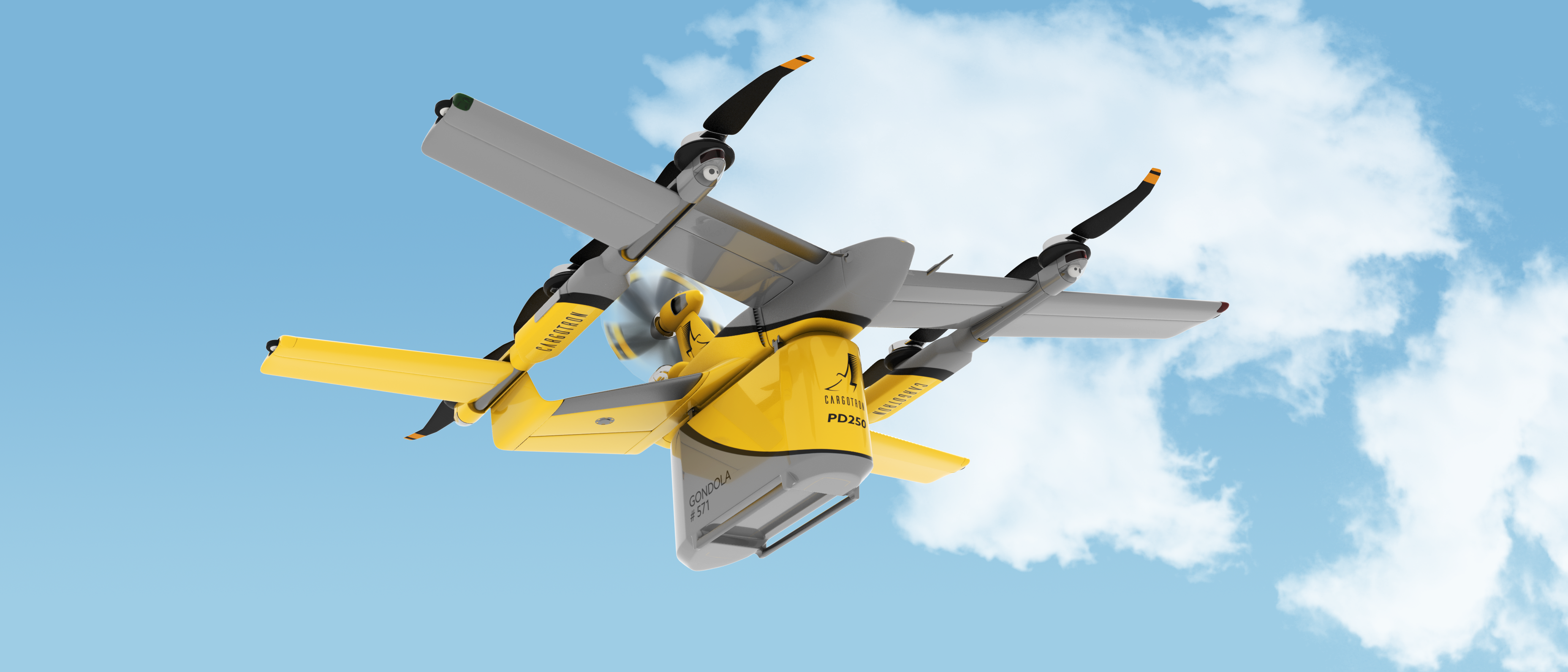CargoTron is entering the contest to bring medium-capacity freight drones to market with plans for a remotely piloted PD250 model that it says will be able to carry a 250-kilogram (550-pound) payload over distances of up to 600 kilometers (375 miles). The Turkish-UK start-up believes the hybrid-electric vehicle will offer greater operational flexibility than alternative vehicles now in development by being able to operate from a 13-meter (42.6-foot) diameter ground footprint, thanks to an innovative design through which a folding wing is transformed into a landing gear.
CargoTron is targeting business-to-business operations in which the PD250 will interface with first-mile/last-mile and mid-mile/feeder operations, bringing loads to locations where goods can be offloaded from cargo pods onto trucks, potentially including electric ground vehicles. It sees its most likely customer base as large freight logistics groups that could operate across clusters of dispersed bases that might include warehouse parking lots and retail/industrial distribution centers.
“We don’t see a bright future for door-to-door delivery drones,” the company’s co-founder, Emre Yazici, told FutureFlight. “CargoTron realized early that a single-step-to-customer or unimodal solution to urban cargo delivery is not practical. Any good solution should take into account existing practices and, of course, the human element.”
So, the company is now assessing options for either manual loading and unloading of the PD250’s cargo pod or a specially designed ground vehicle that could operate autonomously.
According to CargoTron, the PD250 will have 37 percent greater operational efficiency than its closest competitor—a measure that it has reached by multiplying the speed of its vehicle by its cargo capacity and then dividing by the ground footprint from which it can operate. It also claims that its external detachable cargo pod is more flexible than internal cargo bays for different customer requirements, and it intends to offer these in various shapes to accommodate varying load dimensions.
Folding Wings Mean Smaller Operational Ground Footprint
The company has not explicitly named what it views as its closest competitor, but in separate discussions, it mentioned Textron subsidiary Pipistrel, which is working on a drone called the Nuuva V300 that will have a 13.2-meter wingspan. The V300 is expected to have a much larger maximum payload of 2.500 kilograms and a range of up to 2,500 kilometers, but Pipistrel has indicated that more typical operations will involve a 300-kilogram load being carried over around 300 kilometers. Other comparable market entrants might include MightyFly with its Cento drone (and plans for a larger 500-pound-payload version) and Elroy Air with its Chaparral, which has attracted the attention of FedEx.
CargoTron’s calculations for the projected operating footprint of the PD250 are based on the UK Civil Aviation Authority’s CAP 437 regulations governing landing pads on offshore oil platforms and high buildings. Although precise infrastructure regulations for cargo drone operations are not yet fully settled, the company believes EASA’s anticipated new requirements will be fairly similar to CAP 437.
When the PD250’s wing tips are folded down, the wingspan is reduced from 7.2 meters to just 3.8 meters. Yazici explained that the wings fold on a hinge mechanism somewhat similar to that used to deploy landing gear on a fixed-wing aircraft. The wing tips contain small wheels on which the vehicle can rest, with stability provided by boom structures connecting the vehicle's two wings that are twice the thickness of the wings themselves.
“Our folding wing is a simpler design than some of the tilting rotors you see on larger [passenger-carrying] eVTOL aircraft and we believe the [aviation] authorities will be more accustomed to our approach,” Yazici said when asked about possible type certification challenges. For now, it is not clear under what rules cargo drones of this size will be certified, and CargoTron said it has yet to discuss its plan with regulators.
CargoTron intends to power the PD250 with what it describes as a “plug-in” hybrid powerplant that would combine an as-yet-unspecified internal combustion engine with a generator and batteries. The batteries would be recharged during flights and would mainly support the use of electric motors during takeoff and landing, with an additional motor installed with a pusher propeller at the rear of the airframe.
Yazici is a former executive with the helicopter division of Turkish Aerospace Industries, and he formed CargoTron with Ross Kelly, with whom he worked on joint rotorcraft programs with Leonardo. For now, they are leading a small team of four Turkish aerospace engineers, with plans to expand as fundraising efforts bear fruit.
Fundraising Campaign Gets Underway
According to Kelly, the start-up will need little more than $50 million to get to the manufacturing stage, partly due to lower costs in Turkey. However, he is eager for the vehicle to achieve civil certification in the key U.S. and European markets and told FutureFlight that the team will need only 42 months to achieve this once the funding is in place. In May 2022, Yazici applied for patents for aspects of the design, including the folding wing.
The first goal is to raise $15 million to fund a six-month preliminary design phase followed by a further 15 months that the company estimates will be needed to build and fly what it calls a “concept exploration vehicle.” Beyond that, it plans to build an “engineering prototype” and also a conforming “manufacturing prototype.”
In the meantime, Kelly is leading efforts to engage with prospective PD250 operators and gather their feedback on specifications and operational performance. The plan also calls for the creation of a network of distributors and service centers.
